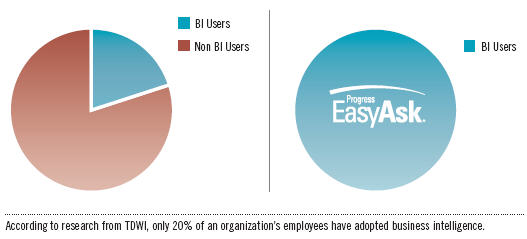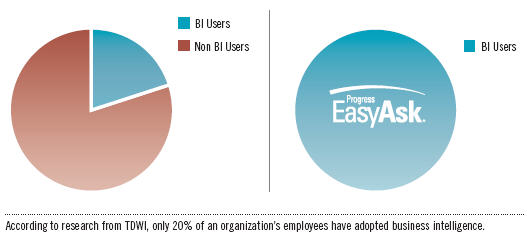
Lesson from the Experts: Giving Business Users the Power to Make Data Actionable
Most business users don’t have access tothe data they need to make better decisions,although most of this data already resides intheir company systems. Search technologycan find data if it exists in a cell, report, ordocument that someone else has generated.But if you’re looking for something new—aggregated, summarized, or trending data thatrequires you to create a new report—thenyou’ll need a technology that conducts analysisas well as search. Historically, businessintelligence (BI) tools have been the answer,but usability has limited accessibility andprevented positive results. TDWI researchreports adoption rates in the low 20%range of users within the enterprise.(Wayne W. Eckerson, TDWI’s Best of BI,Vol. 5, 2007, “Contemplating Consolidation,”p. 14.) The problem is not just the complexityof BI tools, but the need to understandthe data—where it’s stored, what it’s called,and how it’s structured. IT and BI analystshave historically owned the data and accessto it, because they know how to get at it andhave learned the tools of the trade used toleverage it.
By Steve Walsh, Vice President of Strategy and Business Development, Progress Software, EasyAsk Division
Most business users don’t have access to the data they need to make better decisions, although most of this data already resides in their company systems. Search technology can find data if it exists in a cell, report, or document that someone else has generated. But if you’re looking for something new—aggregated, summarized, or trending data that requires you to create a new report—then you’ll need a technology that conducts analysis as well as search. Historically, business intelligence (BI) tools have been the answer, but usability has limited accessibility and prevented positive results. TDWI research reports adoption rates in the low 20% range of users within the enterprise. (Wayne W. Eckerson, TDWI’s Best of BI, Vol. 5, 2007, “Contemplating Consolidation,” p. 14.) The problem is not just the complexity of BI tools, but the need to understand the data—where it’s stored, what it’s called, and how it’s structured. IT and BI analysts have historically owned the data and access to it, because they know how to get at it and have learned the tools of the trade used to leverage it.

Let’s look at an example of someone in a sales role who probably already understands the high level data and would ask questions such as: “Where am I versus quota?” “How much do I have left to hit my goal?” The logical next step is to plan how to reach your goal, with the likely questions being: “What products can I up-sell?” “To whom?” “Which customers bought X and not Y?” A new report is needed that includes specific information that will allow you to act immediately. This information is inherently unique to the specific role, and, in this example, to the specific selling situation based upon where that sales person is versus their goals or plans. This presents the need to look at only a subset of relevant data.
BI companies have tried to address this with drag and drop user interfaces, but it’s difficult to get a drag and drop tool to answer a question such as “Who bought X and not Y?” because a complex query is required (including “sub-selects” and “not exists” clauses in SQL).
Combining the two technologies of search and BI holds promise of a solution. Web search tools have created awareness and acceptance of the “search box” as a user interface that requires little, if any, training. If we marry the search UI to the capabilities of BI tools, the issues of access and usability of information are addressed head on.
Unfortunately, adding a search front end onto a BI tool will only allow you to search for existing BI reports or some cells in the data warehouse. The technology isn’t designed to query structured data using a structured data language like SQL or MDX. Industry analyst commentary recognizes a need for a translation layer—Something that would allow users to express their needs in terms akin to those used for searching, then parse this request into a language that the underlying databases can understand and use to generate a new report. (Forrester, “Search+BI=Unified Information Access,” May 2008.)
The key enabling technology is a natural language processing (NLP) layer that maps and translates the conceptual view of an average business user to the logical view of the structured data, while at the same time surfacing reporting assets (and in the case of integration with an enterprise search technology, other unstructured data). The result is information highly accessible to a vast number of business users with the power to act immediately.
For a free white paper on this topic, click
here and choose the title “Pervasive BusinessIntelligence: Usability Is Key for Casual Users.”For more information about EasyAsk, click
here.
Next
Previous
Back to Table of Contents